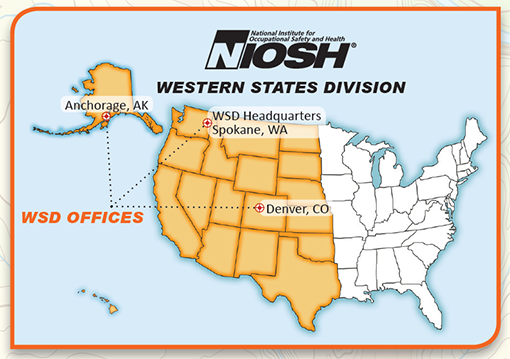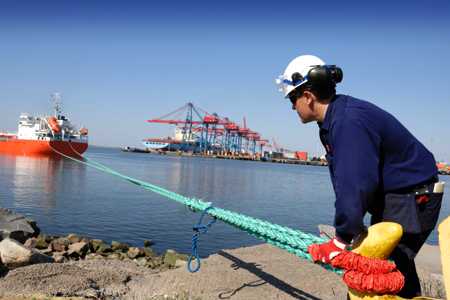Western States Division
 The Western States Division (WSD) consists of NIOSH staff working at three offices located in the Western U.S. to conduct research to reduce a wide variety of occupational safety and health (OSH) hazards. The offices are in Spokane, WA, Denver, CO and Anchorage, AK.
The Western States Division (WSD) consists of NIOSH staff working at three offices located in the Western U.S. to conduct research to reduce a wide variety of occupational safety and health (OSH) hazards. The offices are in Spokane, WA, Denver, CO and Anchorage, AK.
The Western U.S. is experiencing rapid population growth and encompasses a broad range of working environments with a variety of workplace safety and health issues, including consistently high work-related fatality rates in some states. Workers in the Western states may face hazards and issues unique to their environment, including climate extremes, working at altitude, long distance commutes, remote locations and wildland forest fires.
WSD employs a diverse group of public health and safety scientists working together to reduce and eliminate workplace injuries, illnesses, and fatalities. Areas of expertise include industrial hygiene, epidemiology, engineering, occupational medicine and health communication.
The Division employs the public health intervention model for its research programs that includes robust collection and analysis of data, close collaboration with external partners, prioritization of prevention efforts for maximum impact, and development of tailored interventions designed specifically to address the occupational hazards identified. These interventions adhere to the NIOSH research to practice philosophy that emphasizes quality, partnership, relevance, and impact.
WSD SAFETY AND HEALTH RESEARCH AREAS
Oil and Gas Extraction
The fatality rate for the on-shore oil and gas extraction industry is seven times that of general industry. Oil and gas workers face difficult and unique conditions, including extended work shifts, long transportation commutes to remote sites, and considerable use of heavy equipment. Significant risks also exist for exposures to compounds such as hydrogen sulfide, hydrocarbons, and respirable crystalline silica. WSD research identified extremely high worker exposures to respirable crystalline silica during hydraulic fracturing activities and was integral in identifying worker fatalities associated with hydrocarbon exposures during production tank operations. Current research areas include driver fatigue, a NIOSH-designed engineering control to reduce silica exposures, and enhanced surveillance of injuries and illness in this workforce.
Website: https://www.cdc.gov/niosh/programs/oilgas/
Commercial Fishing
Commercial fishing is one of the most hazardous occupations in the United States with a fatality rate 23 times that of general industry. WSD helped reduce the commercial fishing death rate in Alaska by 42% during 1990-2009. This program focuses on epidemiologic research, engineering interventions, policy engagement, and health communication initiatives. The program expanded its scope in 2007 to include all regions of the US in order to promote the same impact on other parts of the country as it had in Alaska. Major achievements include development of an E-stop for deck winches to reduce entanglement injuries, creation of a Hatch and Door Monitoring System to prevent vessel flooding, and influencing Coast Guard and fishing fleet policy changes based on epidemiologic research to address fleet-specific hazards. Current research includes development of winch guards for shrimp boats in the Gulf of Mexico, analysis of non-fatal injuries to commercial fishermen in Alaska and on the West Coast, and ongoing regional analysis of fatalities among commercial fishermen around the United States.
Website: https://www.cdc.gov/niosh/topics/fishing/
Aviation
Long term collaboration with external government and industry partners has reduced air taxi and commuter fatal crashes in Alaska by 53% since the 1990s and reduced controlled flight into terrain (CFIT) fatalities from 7 per year from 1990-1999 to 3 per year from 2000-2009. WSD is currently developing tools to help prevent fatigue in commercial pilots and aviation maintenance workers in Alaska.
Website:https://www.cdc.gov/niosh/topics/aviation/
Wildland Firefighting
Between 2000 and 2013, almost 300 on-duty wildland firefighter (WFF) fatalities occurred. Common hazards faced on the fire line include burnovers/entrapments, heat-related illnesses and injuries, smoke inhalation, vehicle-related injuries (including aircraft), slips, trips, and falls. NIOSH, the U.S. Forest Service, and other partners are reviewing data surveillance systems to understand occupational hazards, personal protective equipment needs and effectiveness, exposures, and fatalities in WFFs.
Website: https://www.cdc.gov/niosh/topics/firefighting/
State Occupational Support
WSD works with many partners, including state and local public health departments, national public health associations, academic institutions and other federal agencies, to enhance the use of state-level public health surveillance data to prevent occupational illnesses, injuries, and hazards. NIOSH, the Council of State and Territorial Epidemiologists (CSTE) and the Mountain and Plains Education and Research Center (MAP ERC) cohost an annual Western States Occupational Network (WestON) meeting that brings together state colleagues to foster networking and capacity building.
Website: http://www.cste.org/group/weston
American Indian, Alaska Native (AIAN) Populations
American Indian, Alaska Native (AIAN) Populations –
American Indians and Alaska Natives are an understudied population, especially when it comes to workplace safety and health. Between 2005 and 2014, there were 358 AIAN workers killed on the job, an average of 36 fatalities per year. In 2013, NIOSH launched an American Indian, Alaska Native Initiative and NIOSH is now partnering with federal agencies, tribes and tribal-serving organizations to provide technical assistance, identify research priorities, sources of data for surveillance and research, and opportunities for collaboration.
Center for Maritime Safety and Health Studies

The ocean environment presents many challenges to those who must protect the safety and health of maritime workers. The NIOSH Center for Maritime Safety and Health Studies (CMSHS) promotes safety and health for this high-risk worker population by coordinating research and intervention studies across NIOSH. CMSHS is a “virtual center” managed by the Western States Division, serving as a hub for intramural researchers to work together on various projects. It also serves as a focus for building research partnerships with stakeholders throughout the U.S. and the world.
Jennifer Lincoln, PhD, CSP - CMSHS Director
Contact the Center at CMSHS@cdc.gov
Website: http://www.cdc.gov/niosh/maritime/
- Page last reviewed: January 24, 2017
- Page last updated: January 24, 2017
- Content source:
- National Institute for Occupational Safety and Health Office of the Director


 ShareCompartir
ShareCompartir